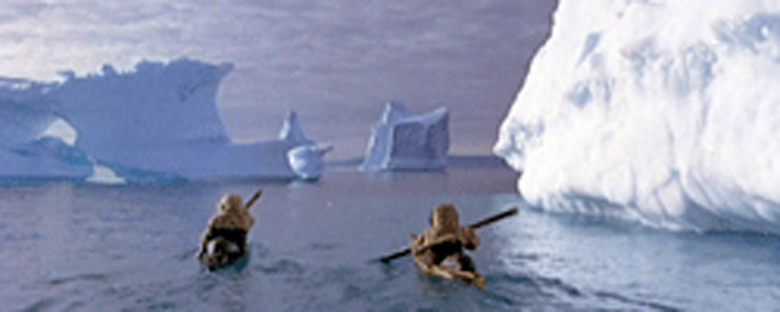Reviews
Les Dents du diable
Nicholas Ray
France / Italy / UK, 1959
Credits
Review by Leo Goldsmith
Posted on 12 March 2006
Source Masters of Cinema / Eureka! DVD
The films of Nicholas Ray explore a great variety of subjects and milieux, from the insect-ridden swamps of Wind Across the Everglades, to the ancient Levant in King of Kings, to the dusty rodeo arenas of The Lusty Men, to the paved and manicured California suburbs of Rebel Without a Cause. But few of Ray’s disparate settings would be as emphatically alien to the viewer as that of The Savage Innocents, a French-Italian-British co-production that Ray shot partly on location in the frozen wastes north of Hudson Bay and partly in the studios at Pinewood.
For much of his career, Ray’s work famously explored what these days we might coyly term “alternative lifestyles.” Indeed, Ray practiced a few himself (drug- and alcohol-user, bisexual, possible statutory rapist), but in film, his concern for the unusual lives of men (messiah, bronc-rider, Audobon warden, disgruntled teen, cortisone addict, etc.) arose out of both a keen anthropological curiosity and a strident devotion to moral relativism. While his films encompass a broad range of subjects and are situated in widely disparate locales, they are united by a shared set of themes: homes and homelessness, the architecture of the family, love triangles (especially those in which the relationship of the two men is the most important), and the shrewd manipulation of genre. These are the common threads that prompted the critics of the Cahiers du Cinéma to place Ray squarely in their canon of auteurs.
The Savage Innocents is Ray’s portrait of Inuit life in the atomic age, and as with all of his later work, the film is a curious blend of melodrama and pseudo-documentary. Voiceover narration elucidates the daily life and social mores of the Inuit hunter and his family, as Ray’s characteristic widescreen (here, Technirama) compositions artfully dissect domestic spaces just as they do in Rebel Without a Cause. The first portion of the film immerses us in this alien world, following Inuk (played by the mighty Anthony Quinn) as he hunts for polar bears, seals, and a useless woman with which to share his igloo. This narrative mode dovetails neatly with the film’s obvious precursor, Nanook of the North: instead of a fictionalized documentary about the Inuits, we have a vérité fiction film. Early in the film, there is even a restaging of Nanook’s famed (and, in fact, staged) tug-of-war with a seal beneath the ice.
It is a full forty minutes before we hear our first crack of modern civilization — a polar bear-felling gunshot from a fellow Inuit who has acquired a rifle from the white man. Inuk’s fascination with this device eventually draws him into the white man’s world, which, with its missionized Eskimo and the ersatz Buddy Holly sound of “Sexy Rock,” now seems more exotic to the viewer than the blue-gray Arctic wasteland. In this outpost on the edge of the frozen hinterlands, a miniature cultural war will be enacted, with the boyish, absurdly hardy Inuk pitted unwittingly against the alternately craven, opportunistic, and proselytizing whites. On the verge of these vast expanses of ice, Christian morals sit awkwardly with the laws of Inuk’s ancestors, and when a white preacher insults Inuk by refusing to bed with the hunter’s wife (apparently a common enough practice amongst the Inuit), Inuk impulsively cracks the missionary’s well-meaning skull.
The ethnographic project in which The Savage Innocents participates is rather typical for its day, combining both exotic cultural factoids and banal universalisms. On the one hand, the film makes much of the Inuit’s practice of wife-swapping, but on the other, it platitudinizes that Eskimos are people, too (like any capricious pregnant woman, Inuk’s wife fancifully demands a dinner of musk ox, the Arctic equivalent of pickles and ice cream). In this way, the film often shows its age, as it does with Peter O’Toole’s regrettable spaghetti-western dubbing and with the rather sloppy matching of the astonishing location footage and the inert studio photography. (Like Contempt, the film and its production history offer a fascinating window into international film production of the time, with a multilingual crew braving the frozen Arctic for one half of the shoot and enduring the sweltering and unsympathetic Pinewood Studios for the other.)
Although the portrait of Inuit culture lacks a certain modern sophistication, it is nonetheless a tribute to Ray’s steady gaze that he does not essentialize or idealize the Inuk’s way of life. Notwithstanding the film’s title, at no point does Inuk’s lifestyle (with its images of raw seal-offal cuisine and of the elderly sacrificing themselves to polar bears) seem the apex of a Rousseauvian uncorrupted human innocence. The film certainly valorizes Inuk as its rugged protagonist, but it does not make of his world a lost paradise. Like the contemporary work of Jean Rouch, The Savage Innocents is not so much an idealization of “primitive” cultures, but a case study in the irreconcilability of the moral orders by which humans live.
We don’t do comments anymore, but you may contact us here or find us on Twitter or Facebook.



